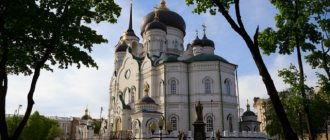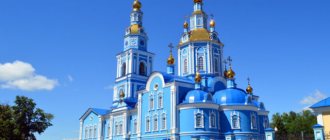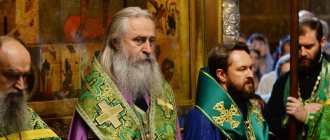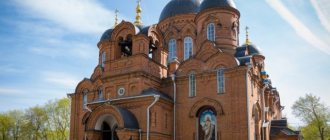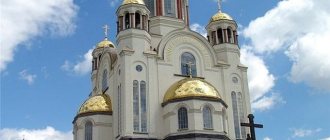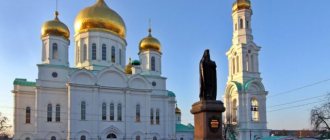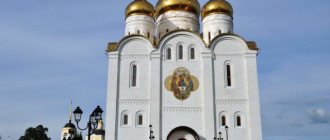| Cathedral in the name of the Most Holy Life-Giving Trinity in the city of Saratov (“Old Cathedral”), 2009. |
Saratov and Volsk diocese
of the Saratov Metropolis of the Russian Orthodox Church
- Diocesan administration: Russia, 410056, Saratov, st. Volskaya, 55
- Phone (office) Fax: (8452) 73-70-72
- Official site:
- Canonical territory: Atkarsky, Bazarno-Karabulaksky, Baltaysky, Volsky, Voskresensky, Novoburassky, Petrovsky, Saratovsky, Tatishchevsky, Khvalynsky districts of the Saratov region.
- Cathedral: Trinity in Saratov
- On the map: Yandex.Map, Google map
The first period of the formation of Christianity in the Volga region dates back to the time of the Khazar Khaganate (see more details), within which the Faith of Christ began to be established no later than a century. From the end of the 9th century, information about Christianity in the Lower Volga region disappeared for almost four centuries, until the establishment of the Sarai See here (see details) in 1261. After the establishment of the Kazan diocese in 1555, the lands around Saratov, which was first mentioned in 1590, belonged to it. In the 17th century, this region came under the jurisdiction of the Astrakhan bishops.
The first institution as part of the Penza diocese
On October 16, 1799, the independent Saratov and Penza diocese was separated from Tambov. However, “ due to the lack of convenient premises in Saratov for bishops and the spiritual consistory
“The first bishop of the new see, Gaiy (Tokaov), achieved the move of the see to Penza and the name of the diocese was changed to Penza and Saratov in 1803. During his stay as part of the Penza diocese, the majestic Alexander Nevsky Cathedral was founded in Saratov in 1815, dedicated to the Saratov militias and the victory of the Russian people in the Patriotic War of 1812, in 1820 the Saratov Theological School was established, and by the beginning of 1822 the Spaso- Transfiguration Monastery.
Second establishment and pre-revolutionary period
The Secret Committee on Cases of Dissenters drew special attention of Emperor Nicholas I to the strengthening of the schism in the Saratov province, as a result of which the sovereign ordered on October 20, 1828 to restore an independent department in Saratov. The Holy Synod decided on October 21 that the Saratov diocese should be third-class (after Penza), called Saratov and Tsaritsyn, and that the new bishop should initially reside in the Saratov Transfiguration Monastery. On November 3 of the same year, the decision of the Synod was approved by the emperor.
The revitalization of the spiritual life of the Saratov region was marked by the restoration of the women's Holy Cross Monastery in 1829 and the creation of the Saratov Theological Seminary in 1830. The reign of Bishop Jacob (Vecherkov) (1832-1847) was marked by the spread of common faith among the Old Believers, the conversion of thousands of Kalmyks and Jews to Orthodoxy, the opening of three new theological schools (Nikolaevsky, Volsky, Balashovsky), and the construction of many churches and prayer houses. In 1849, the Volsky Vicariate was briefly established for the Saratov department, which was subsequently restored on a permanent basis in 1898. In 1865, the publication of the magazine “Saratov Diocesan Gazette” began, in 1869 the first women’s diocesan school was opened in Saratov, and in 1900 the second one was opened in Volsk.
Since 1917
During the Time of Troubles, immediately after the revolution, the Volgograd vicar diocese was established, which was subsequently independent for some time.
The persecution of Orthodoxy within the Saratov diocese was especially fierce in the first half of the 1930s - the Alexander Nevsky Cathedral was blown up, many churches were destroyed or taken away from believers. By the end of the 1930s, there was not a single functioning church left in the Saratov diocese; most of the clergy were either shot or were in camps and exile.
In the 1920-30s there was a Saratov renovationist diocese.
During wartime, church-government relations changed, and in 1942, after a five-year break, the Saratov bishop was again appointed, whose territory of administration was limited to the Saratov region [1]. In the second half of that year, the Holy Trinity Cathedral in Saratov was leased, and in 1947, the Holy Trinity Cathedral was finally returned to the Orthodox Church, the miraculous image of the Savior Not Made by Hands was transferred from the local history museum, and the liturgical life of the Saratov diocese was resumed. From 1947 to 1961, the Saratov Theological Seminary operated again. During this period, when the Saratov bishops were entrusted with the simultaneous administration of the Stalingrad diocese, their title was changed to “Saratov and Stalingrad.”
In the new round of the anti-religious campaign in the USSR, church life was again suppressed; by mid-1964, there were only two functioning churches left in Saratov: the Trinity and the Holy Spiritual Cathedrals.
Recent period
The revival of church life within the USSR since the late 1980s was expressed in the restoration of the Saratov Theological Seminary and the Saratov Diocesan Gazette, the opening of dozens of churches in the first half of the 1990s, and the return of the Alexievsky Convent to the Church. Thanks to new opportunities, the diocese's publishing and broadcasting activities expanded.
For better care of the flock, on January 31, 1991, the independent Volgograd diocese was again separated from the Saratov diocese.
On October 5, 2011, two parts of the Saratov region were separated from the Saratov diocese, on the territory of which independent dioceses were formed [2]:
- Balashov diocese (within the administrative boundaries of Arkadaksky, Balashovsky, Ekaterinovsky, Kalininsky, Krasnoarmeysky, Lysogorsky, Romanovsky, Rtishchevsky, Samoilovsky and Turkovsky districts of the Saratov region),
- Pokrovsky diocese (within the administrative boundaries of Alexandrovo-Gaisky, Balakovsky, Dergachevsky, Dukhovnitsky, Ershovsky, Ivanteevsky, Krasnokutsky, Krasnopartizansky, Marksovsky, Novouzensky, Ozinsky, Perelyubsky, Pitersky, Pugachevsky, Rivne, Sovetsky, Fedorovsky and Engelsky districts of the Saratov region).
On October 6, 2011, the Saratov Metropolis was formed within the Saratov region, which includes the Balashov, Intercession and Saratov dioceses. The head of the metropolitanate was determined to be the Saratov bishop [3].
Historical names
- Saratov and Penza (October 16, 1799 - December 4, 1803)
- Penza and Saratov (December 4, 1803 - November 3, 1828) (see)
- Saratov and Tsaritsyn (November 3, 1828 - 1917)
- Saratovskaya and Petrovskaya (1917 - 1942)
- Saratovskaya (October 14, 1942 - July 8, 1943)
- Saratov and Stalingrad (July 8, 1943 - 1945)
- Saratovskaya and Volskaya (1945 - 1953)
- Saratov and Stalingrad (1953 - 1954)
- Saratov and Volskaya (?)
- Saratovskaya and Balashovskaya (1954 - December 26, 1957)
- Saratovskaya and Volskaya (December 26, 1957 - July 15, 1959)
- Saratov and Stalingrad (July 15, 1959 - 1961)
- Saratov and Volgograd (1961 - January 31, 1991)
- Saratovskaya and Volskaya (since January 31, 1991)
Statistics
- October 16, 1799 - ca. 800 thousand Christian souls, 615 churches and 10,616 persons belonging to the clergy, of which 2,511 were serving clergy.
- 1828 - 545 churches, more than 2,500 clergy, over a million Christian souls.
- 1912 - churches - 897, chapels - 159; monasteries - 13 (11 women's); theological seminary, 5 theological schools, 1 diocesan women's school, 981 church schools; libraries at churches - 526; hospitals - 9, almshouses - 36.
- 1936 - out of 53 districts of the Saratov Territory, 34 districts had no functioning churches. Over 500 churches were occupied by the authorities for the storage of collective farm grain.
- January 1, 1958 - 45 registered temples/houses of worship [4]
- 1964 - two operating churches in Saratov.
- February 2012 - 132 active parishes, 174 clergy (including 150 priests, 24 deacons), 21 monastics (including 7 abbots, 10 hieromonks, 4 hierodeacons)
- December 2012 - 131 registered parishes, 8 unregistered, 180 clergy (of which 155 priests and 25 deacons), 20 monastic clergy (of which 7 abbots, 9 hieromonks, 4 hierodeacons), 21 nuns of women’s monasteries (15 mantle nuns, 6 robed nuns) [5]
- December 2013 - 140 registered parishes, 10 unregistered, 10 chapels, 5 monasteries, 195 clergy (of which 164 priests and 31 deacons), monastics - 22 people (of which abbots - 8, hieromonks - 10, hierodeacons - 4)[6]
- March 2015 - 151 parishes; 196 clergy and religious, incl. 167 priests, 29 deacons, of which 22 monastics (8 abbots, 11 hieromonks, 3 hierodeacons) [7]
Bishops
- Gaiy (Takaov) (October 16, 1799 - December 4, 1803)
- 1803 - 1828 - see Penza rulers
- Iriney (Nesterovich) (November 3 - November 29, 1828)
- Moses (Bogdanov-Platonov)) (November 29, 1828 - March 12, 1832)
- Jacob (Vecherkov) (March 27, 1832 - January 13, 1847)
- Afanasy (Drozdov) (January 13, 1847 - April 15, 1856)
- Ioannikiy (Gorsky) (April 15, 1856 - July 17, 1860)
- Evfimy (Belikov) (August 29, 1860 - October 17, 1863)
- Ioannikiy (Rudnev) (January 13, 1864 - July 13, 1873)
- Tikhon (Pokrovsky) (July 13, 1873 - March 6, 1882)
- Pavel (Vilchinsky) (April 5, 1882 - December 16, 1889)
- Abraham (Letnitsky) (December 16, 1899 - October 24, 1893)
- Nikolai (Nalimov) (November 13, 1893 - January 16, 1899)
- John (Kratirov) (February 3, 1899 - March 12, 1903)
- Sschmch. Ermogen (Dolganev) (March 21, 1903 - January 17, 1912)
- Alexy (Dorodnitsyn) (January 17, 1912 - July 30, 1914)
- Palladium (Dobronravov) (July 30, 1914 - August 25, 1917)
- Dosifey (Protopopov) (August 25, 1917 - October 27, 1927)
- Andrey (Komarov) (January 14, 1924 - March 6, 1926) v/u
- Sergius (Poletkin) (January - August 19, 2003) supreme, archbishop. Samara
Diocesan departments
There are about 15 departments in the diocesan administration, among them the department:
- the relationship between the Church and the public;
- church education and catechesis;
- on working with children and youth;
- on working with law enforcement agencies and the military;
- on working with the Cossacks;
- prison ministry;
- charity and social service;
- missionary service;
- commission for the canonization of ascetics;
- architecture and restoration;
- legal and economic service.
The main diocesan website contains contact information for each department.
Geography of deaneries
- Central (Kirovsky, Frunzensky, Oktyabrsky districts of Saratov)
- Atkarskoye (Atkarsky district - )
- Bazarno-Karabulakskoye (Bazarno-Karabulaksky district - ):
- r.p. Bazarny Karabulak, village. Alekseevka, s. Vyazovka, village Kazanla, s. Kutino, s. Lesnaya Neelovka, village Lipovka, village Maksimovka, r.p. New Burasy, village. Cut your hair, s. Sukhoi Karabulak, village. Teplovka, r.p. Grip
Deanery
The canonical territory is represented by the deaneries of the Saratov diocese with deans:
- Central - priest Igor Moskvichev;
- Atkarskoye - priest D. Elistratov;
- Bazarno-Karabulakskoye - priest N. Protasov;
- Baltaiskoe, Volskoe, Voskresenskoe - priest I. Kuznetsov;
- All Saints - Archpriest A. Domrachev;
- Novoburasskoye - priest N. Protasov
- Petropavlovskoe - Archpriest R. Pavlov;
- Petrovskoe - priest S. Protasov;
- Tatishchevskoe - priest A. Chebotarev;
- Trinity - priest N. Gensitsky;
- Khvalynskoe - Archpriest V. Kolpachenko.
There are 175 parishes in the diocese, under the direction of 180 priests, 30 deacons, 24 monastics, including an archimandrite, twelve hieromonks, and four hierodeacons. The ruling bishop Longin (Korchagin) has held his post since 2003.
Metropolitan Longinus of Saratov and Volsk
Periodicals
- "Saratov Diocesan Gazette"
- “Orthodox Faith” (newspaper, since December 1992, published twice a month)
- "Orthodoxy and Modernity" (quarterly magazine)
- “Glas” (information sheet of the Central Deanery, published twice a month)
- “Trinity leaf” (monthly newspaper of the Trinity deanery)
- “Orthodox newspaper of the Volsky deanery” (monthly publication)
- “Pokrovsky leaflet” (monthly information leaflet of the Petrovsky deanery)
Russian Orthodox Church
It is part of the Saratov Metropolis.
The first Orthodox diocese on the territory of the present Saratov region was opened in 1261. After the capture of Kazan in 1552, the Kazan diocese was formed, which included Saratov. With the establishment of the archbishopric in Kazan, the Upper Volga region with the northern part of the current Saratov province was assigned to it; the southern part of the region remained part of the Sarai diocese until 1602. Saratov and the northern part of the Saratov province in diocesan terms were initially under the jurisdiction of the “Office of the Kazan Palace”, located in Moscow. In 1602, churches along the Volga were assigned to it, starting from Saratov to the south, along Medveditsa and Khopru to the Don. Saratov, under the church department, moved to the Astrakhan diocese, the hierarchs of the diocese were called “Astrakhan and Terek”.
On October 16, 1799, the Saratov-Penza diocese was established. In November 1828, the Saratov diocese was separated into an independent church-administrative unit.
By the decision of the Holy Synod of October 5-6, 2011 (magazine No. 105), the Balashov and Intercession dioceses were separated from the Saratov diocese.
Diocese today (as of June 2021)
Deaneries and deaneries
- Atkarskoye - Priest Roman Bolotnov
- Bazarno-Karabulakskoe - Priest Nikolai Protasov
- Baltaiskoye - priest Vadim Derzhavin
- Volskoe - Archpriest Alexy Zemtsov
- Resurrection - Priest Sergius Tuigin
- Monastyrskoye - Hieromonk Nikandr (Pylyshyn)
- Novoburasskoe - Priest John Kovach
- Petrovskoe - priest Sergiy Protasov
- Saratov North-Eastern - Priest Alexander Borodovitsyn
- Saratov North-West - priest Oleg Grushin
- Saratov South - Archpriest Alexander Domrachev
- Saratov Central - Priest Alexander Chebotarev
- Tatishchevskoye - priest Alexy Novichkov
- Khvalynskoye - Archpriest Pavel Usov
Monasteries
men's:
- Nikolsky 410004, Saratov, st. Degtyarnaya, 26; tel.; Fax; e-mail abbot - abbot Nikon (Polyakov)
- monastery courtyard 412176, Saratov region, Tatishchevsky district, village. Sleptsovka, st. Sovetskaya, 84A rector - Hieromonk Tikhon (Chernov)
women's:
- Aleksievsky 410009, Saratov, Zamkovy proezd, 18; tel.; website svyatalm.ru, e-mail abbess - abbess Feodosia (Bessonova)
- Sergievsky 412606, Saratov region, Bazarno-Karabulaksky district, village. Alekseevka, st. Sovetskaya, 31; tel. (84591) 6-65-03; website www.sergius-of-radonezh.de; e-mail abbess - abbess Sergia (Plahotnik)
- monastery courtyard 412605, Saratov region, Bazarno-Karabulaksky district, village. Ivanovka abbess - abbess Sergius (Plahotnik)
active parishes .
The number of clergy and monastics is 220, including:
- priests - 199;
- deacons - 21.
Of these, 26 are monastics, including:
- abbots - 7;
- hieromonks - 16;
- hierodeacons - 3.
Educational establishments
- Saratov Orthodox Theological Seminary 410031, Saratov, st. Michurina, 92; tel./fax (8452) 49-18-44; e-mail
secondary educational institutions
- Educational Center for the Development of Children and Youth Creativity at the Saratov Theological Seminary 410031, Saratov, st. Lermontova, 28; tel., 44-82-43; e-mail
- Pokrovskaya Orthodox Classical Gymnasium 410003, Saratov, st. Gorky, 83; tel./fax (8452) 26-47-27; e-mail
- Khvalynsk Orthodox classical gymnasium in the name of the holy martyr Alexander Medem 412780, Saratov region, Khvalynsk, st. them. K.S. Petrova-Vodkina, 20; tel./fax (84595) 2-18-80; e-mail
Mass media
- Information and Publishing Department of the Saratov Diocese 410031, Saratov, st. Radishcheva, 24; tel.; e-mail
print mass-media
- “Orthodox Faith” (newspaper, published twice a month)
- “Trinity Leaf” (parish newspaper of the Holy Trinity Cathedral in Saratov, published once a month)
- “Preobrazhensky Leaflet” (parish newspaper of the Spaso-Preobrazhensky Monastery in Saratov, published monthly)
TV
- “Events of the Saratov Metropolitanate” (broadcast on Sundays at 14.30, channel “Russia-24”)
Internet resources, including deanery websites
- Information and analytical portal of the Saratov Metropolitanate “Orthodoxy and modernity”
- website of the Saratov Orthodox Theological Seminary
- website of the Intercession Orthodox Classical Gymnasium in Saratov
- Website of the Khvalynsk Orthodox classical gymnasium in the name of the holy martyr Alexander Medem
- website of the youth department of the Saratov diocese
- website of the department of religious education and catechesis of the Saratov diocese
- website of the pilgrimage service of the Saratov diocese
- website of the missionary department of the Saratov diocese
- website of the department of church charity and social service
- Saratov Central Deanery - https://centr-blg-sar.ru/
- Saratov North-Eastern Deanery - https://www.troick-blago.ru/
- Saratov North-Western Deanery - https://petropavlovskoe64.ru/
- Saratov Southern Deanery - https://vsblag.ru/
- Atkar Deanery - https://atkarsk.blagochin.ru/
- Bazarno-Karabulak deanery - https://svt-nikolay.blagochin.ru/
- Baltai Deanery - https://baltay.blagochin.ru/
- Volsk Deanery - https://www.volsk-blago.ru/
- Resurrection Deanery - Church of the Life-Giving Trinity. Voskresenskoye
- Novoburas deanery - https://nbhram.cerkov.ru/
- Petrovskoye Deanery - https://petrovsksar.blagochin.ru/
- Tatishchevsky deanery - https://saratov-tatishev.blagochin.ru/
- Khvalynsk Deanery - https://hvalynsk.prihod.ru/
Literature
- Pravdin, A. M., Historical note about the Saratov diocese (for the 50th anniversary of 1828-1878)
, Saratov, 1879, 48 p. - Reference book of the Saratov diocese
, Saratov, 1912, X, 706 p. - Valeev, V., From the history of Saratov churches
, Saratov: “Volga Book Publishing House”, 1990, 208 p. - Vorobyov, M., prot., Orthodox local history.
Essays on the history of the Saratov region , M.: "Line Graphic", 2002, 196 p. - Lanchikov, B., prot., History of the Saratov Diocese
, Sergiev Posad: Publishing House of the Trinity-Sergius Lavra, 1999, 202 p. - Novikov, A.P., Barzilov, S.I., Hierarchs of the Russian Land: Biographical sketches of Saratov bishops
, Saratov: “Compatriot”, 2000, 367 pp. - Yakovlev, A. A., Teplov, V. V., Plyakin, M. E., Saratov ascetics
, Saratov: “Chronicle”, 2000, 192 p.
History of formation
The Saratov lands at the time of the appearance of the first Christians, and this is the end of the 5th, beginning of the 6th centuries, were under the possession of the Khazars. Then some information emerges about Christian activity in this region at the end of the 9th century, then for almost 400 years nothing was heard about Orthodoxy in the Volga region.
In 1261, the Sarai See was formed; by 1590, the Saratov region was included in the Kazan diocese, formed in 1555; in the 17th century it was under the protection of the Astrakhan Bishops.
The 19th century can be called the heyday of Orthodoxy in the Volga region. When the Saratov and Penza diocese was founded in 1799 under the leadership of Bishop Gaius (Takaov) with a see in Penza, in 1803 the name was changed to Penza and Saratov.
The Alexander Nevsky Cathedral was dismantled in 1938
In 1815, the Alexander Nevsky Temple was opened in Saratov, and in 1822, the men's monastery of the Transfiguration of the Lord.
The schismatic movement became the reason for the founding, by decree of Nicholas the First, of an independent department in Saratov in 1828.
The restoration of the women's Holy Cross Convent in 1829 and the opening of the Theological Seminary in Saratov in 1830 significantly revived spiritual life in the region.
In 1869, schools for women were opened in Saratov, in 1900 - in Volsk.
After 1917, all Orthodox churches were blown up. For ten years, from 1920, there was a renovation department.
The restoration of the Saratov diocese of the Russian Orthodox Church begins in 1942, in 1947 the Cathedral Church of the Holy Trinity returns, and the theological seminary opens its doors. At the same time, the bishops of Saratov also governed the deaneries of Stalingrad, but in 1964 a period of suppression of Christian activity began again.
Holy Trinity Cathedral of Saratov
Only in 1991 did the Volgograd diocese appear. October 5, 2011 is the time of the emergence of an independent modern Saratov diocese, uniting the Intercession, Balashov and Saratov departments.
Active monasteries
There are four women's and two men's monasteries on the territory of the diocese.
The Alekseevskaya Ioannovskaya Convent received its name in honor of St. John of Kronstadt, who served here in 1894. Majestically, like God’s candle, she stands on the hill of the village of Alekseevka.
St. Alexievsky Convent
The Sergievsky Convent in the village of Alekseevka, Bazarno-Karabulak district, has become a place of pilgrimage since 2007
The Volskaya Vladimir monastery, opened in 2015, is the custodian of the shrine - the miraculous icon of the Mother of God “Vladimir”.
The majestic monastic buildings of the Saratov Alekseevsky Convent are visible from afar. The shrines of the monastery attract parishioners and pilgrims from all over the world.
The Nikolsky Monastery cannot boast of unique architecture, but this shrine has become a real center of nourishment for the city’s residents.
In 1994, the Spaso-Preobrazhensky Monastery in Saratov was consecrated, the custodian of the relics of many saints and righteous people.
Spaso-Preobrazhensky Monastery
